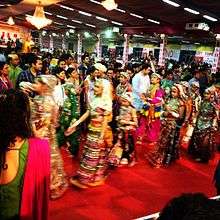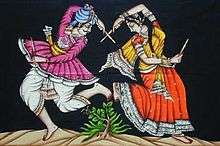Dandiya Raas
Raas or Dandiya Raas is the socio-religious folk dance originating from Indian state of Gujarat and popularly performed in the festival of Navaratri.[1][2] The dance is performed in the Marwar region of the Rajasthan too.[3]

Etymology

The word "Raas" comes from the Sanskrit word "Rasa", an aesthetic Indian concept related to emotions and feelings. Kapila Vatsyayan argued that aesthetic theory of the Rasa gives the underlying unity to the Indian arts.[4]
Forms of Raas
Dandiya Raas, Gopgunthan Solanga Raas and Mer Dandiya Raas are the popular forms of Raas. In Saurashtra, Raas is performed by the men and the dance performed by women is called as Raasda. Element of dance is more prominent in the Raas while music is more prominent in Raasda.[2]

Format
Both men and women traditionally play dandiya-raas and the dance operates in pairs, meaning the group must contain an even number. Generally two lines are formed, with partners facing each other:
The lines move clockwise, and each person steps forward to hit sticks with their partner, then moves on two people. At the end of the line, each turns and joins the line opposite, so the movement is continuous. The music starts very slowly […] It is an eight-beat time cycle called Kaherva and performed in the following manner: on the first beat your own sticks are hit together, followed by right sticks with your partner, then left sticks (or the same stick if using one). Each one then turns away to the left to hit their own sticks together before turning back to the partner to hit right sticks again, and before moving on two places to a new partner.[5]
References
- Education, International Society for Music (1984). ISME Yearbook. B. Schott's Söhne. p. 118.
- Sharma, Manorma (2007). Musical Heritage of India. APH Publishing. p. 59. ISBN 9788131300466.
- Khyāta: itihāsa, kalā, evaṃ saṃskr̥ti kī śodha patrikā (in Hindi). Marubhūmi Śodha Saṃsthāna. 2002. p. 240.
- Vatsyayan, Kapila (1987). Traditions of Indian folk dance. Clarion Books associated with Hind Pocket Books. p. 5.
- David. Performing faith. pp. 138–9.
External links
| Wikimedia Commons has media related to Dandiya Raas. |